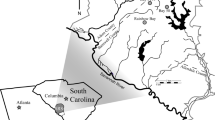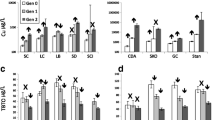Abstract
This study documents the effects of short-term (24h) sublethal copper exposures on undirected swimming activity and photobehavior of Balanus improvisus stage II nauplii. All Cu treatments were static, with temperature and salinity conditions at 20°C and 15 or 30‰. The 24h LC 50 estimate for Cu is 88 ppb at 15‰ and >200 ppb at 30‰. Sub-lethal Cu concentrations cause reductions in swimming speed, which decrease progressively with increasing Cu dose. At 50 ppb Cu, this was significant primarily at light intensities below the phototactic threshold. At higher Cu concentrations, significant reductions in mean linear velocity occurred at most light intensities tested. At 30‰, 50 and 100 ppb Cu also reduce the positive phototactic response and 150 ppb Cu causes reversal of phototaxis at optimal intensities. Photokinesis is reduced at 100 ppb Cu and disappears at 150 ppb Cu. At 15‰, the behavioral effects of 50 ppb Cu resemble those occurring with 150 ppb Cu at 30‰. Swimming speed and photobehavior show promise as sensitive behavioral indicators of copper toxicity. Additional research is required to determine if these responses apply to a broad range of pollutants and to other planktonic organisms. There is also a need to further evaluate the significance of these behavioral effects ecologically.
Similar content being viewed by others
Literature Cited
Amiard, J.-C.: Les variations de la phototaxie des larves de crustacés sous l'action de divers polluants métalliques: mise au point d'un test de toxicité subléthale. Mar. Biol. 34, 239–245 (1976)
Ahsanullah, M. and G. H. Arnott: Acute toxicity of copper, cadmium, and zinc to larvae of the crab Paragrapsus quadridentatus (H. Milne Edwards), and implications for water quality criteria. Aust. J. mar. Freshwat. Res. 29, 1–8 (1978)
Bar, A. J., J. H. Goodnight, J. P. Sall and J. T. Helwig: A user's guide to SAS 76, 329 pp. Raleigh, North Carolina: SAS Institute Inc. 1976
Batschelet, E.; Statistical methods for the analysis of problems in animal arientation and certain biological rhythms, 57 pp. Washington D. C.: American Institute of Biological Science 1965
Black, G. A. P., D. J. Hilton, H. C. Johnston and J. B. Sprague: Annotated list of copper concentrations found harmful to aquatic organisms. Fish. Mar. Serv. (Canada) Tech. Rep. 603, 1–44 (1976)
Bowen, H. J. M.: Trace elements in biochemistry, 241 pp. New York: Academic Press 1966
Connor, P. M.: Acute toxicity of heavy metals to some marine larvae. Mar. Pollut. Bull. 3, 190–192 (1972)
Davis, J. C.: Progress in sublethal effect studies with Kraft pulpmill effluent and salmonids. J. Fish. Res. Bd Can. 33, 2031–2035 (1976)
Eisler, R.: Acute toxicities of selected heavy metals to the softshell clam Mya arenaria. Bull. envir. Contam. Toxicol. 17, 137–145 (1977)
Eisler, R.: Behavioral responses of marine poikilotherms to pollutants. Phil. Trans. R. Soc (Ser. B) 286, 507–521 (1979)
Ewald, W. F.: On artificial modification of light reactions and the influence of electroytes on phototaxis. J. exp. Zool. 13, 591–612 (1912)
Forward, R. B., Jr. and J. D. Costlow, Jr.: Crustacean larval behavior as an indicator of sublethal effects of an insect juvenile hormone mimic. Estuar. Process. 1, 279–289 (1976)
Forward, R. B., Jr. and J. D. Costlow, Jr.: Sublethal effects of insect growth regulators upon crab larval behavior. Water Air Soil Pollut. 9, 227–238 (1978)
Gibson, V. R. and G. D. Grice, Response of macrozooplankton populations to copper; controlled ecosystem pollution experiment. Bull. mar. Sci. 27, 85–91 (1977)
Graves, J. O. B.: The bugsystem: The software structure for reduction of quantized video data of moving organisms. Proc. Inst. Electrical Electronics Eng. 63, 1415–1425 (1975)
Greaves, J. O. B. and R. S. Wilson: Development of an interactive system to study sub-lethal effects of pollutants on the behavior of organisms. Cincinnati, Ohio: Office of Research and Development, U. S. Environmental Protection Agency (Ecol. Res. Series Report, EPA-600/3-80-010) 1980
Harrison, W. G., R. W. Eppley, and E. H. Renger: Phytoplankton nitrogen metabolism, nitrogen budgets, and observations on copper toxicity: controlled ecosystem pollution experiment. Bull. mar. Sci. 27, 44–57 (1977)
Jones, M. B.: Effects of copper on survival and osmoregulation in marine and brackish water isopods (Crustacea). In: Proc. 9th European Marine Biology Symposium, pp 419–431. Ed. by H. Barnes. Aberdeen Univ. Press 1975
Lang, W. H.: Larval development of shallow water barnacles of the Carolinas (Cirripedia: Thoracica) with keys to naupliar stages. 39 pp. Washington, D.C.: Technical Information Division, National Oceanic and Atmospheric Administration (NOAA Tech. Rep. NMFS Circ. 421) 1979
Lang, W. H., R. B. Forward, Jr. and D. C. Miller: Behavioral responses of Balanus improvisus nauplii to light intensity and spectrum. Biol. Bull. 157, 166–181 (1979a)
Lang, W. H., S. Lawrence, and D. C. Miller: The effects of temperature, light, and exposure to sublethal levels of copper on the swimming behavior of barncale nauplii. In: Advances in marine environmental research, proceedings of a symposium, pp 273–289. Ed. by F. S. Jacoff. Narragansett, Rhode Island: Office of Research and Development, U.S. Environmental Protection Agency (EPA-600/9-79-035) 1979b
Lang, W. H., M. Marcy, P. J. Clem, D. C. Miller and M. R. Rodelli: The comparative photobehavior of laboratory0hatched and plankton-caugh Balanus improvisus (Darwin) nauplii and the effects of 24-hour starvation. J. exp. mar. Biol. Ecol. 42, 201–212 (1980)
Macek, K. J. and B. H. Sleight II: Utility of toxicity tests with embryos and fry of fish in evaluating hazards associated with the chronic toxicity of chemicals to fishes. In: Aquatic toxicology and hazard evaluation. pp 137–146. Ed. by F. L. Mayer and J. L. Hamelink. Philadelphia: American Society for Testing and Materials 1977
McKim, J. M. and D. A. Benoit: Effects of long-term exposures to copper on survival, growth and reproduction of brook trout (Salvelinus fontinalis). J. Fish. Res. Bd Can. 28, 655–662 (1971)
McKim, J. M., G. F. Olson, G. W. Holcombe and E. P. Hunt: Long-term effects of methylmercuric chloride on three generations of brook trout (Salvelinus fontinalis): toxicity, accumulation, distribution, and elimination. J. Fish. Res. Bd Can. 33, 2726–2739 (1976)
McLeese, D. W.: Toxicity of copper at two temperatures and three salinities to the American lobser (Homarus americanus). J. Fish. Res. Bd Can. 31, 1949–1952 (1974)
Menzel, D. W.: Summary of experimental results: controlled ecosystem pollution experiment. Bull. mar. Sci. 27, 142–145 (1977)
Miller, D. C.: Some applications of locomotor response in pollution effects measurement. Rapp. p.-v. Réun. Cons. int. Explor. Mer. 179, 154–161 (1980)
Moraitou-Apostolopoulou, M.: Acute toxicity of copper to a copepod. Mar. Pollut. Bull. 9, 278–280 (1978)
Moraitou-Apostolopoulou, M. and G. Verriopulos: Some effects of sub-lethal concentrations of copper on a marine copepod. Mar. Pollut. Bull. 10, 88–92 (1979)
Mount, D. I.: Chronic toxicity of copper to fathead minnows (Pimephales promelas, Rafinesque). Wat. Res. 2, 215–223 (1968)
Mount, D. I. and C. E. Stephan: Chronic toxicity of copper to the fathead minnow (Pimephales promelas) in soft water. J. Fish. Res. Bd Can. 26, 2449–2457 (1969)
Olla, B. L. (Ed.): Behavioral bioassays. In: Marine bioassays, workshop proceedings, pp. 1–31. Chairman, G. V. Cox. Eashington, D.C.: Marine Technology Society 1974
Olson, K. R. and R. C. Harrel: Effect of salinity on acute toxicity of mercury, copper and chromium for Rangia cuneata (Pelecypoda, Mactridae). Contrib. mar. Sci. 17, 9–13 (1973)
Pyefinch, K. A. and J. C. Mott: The sensitivity of barnacles and their larvae to copper and mercury. J. exp. Biol. 25, 276–298 (1948)
Reeve, M. R., G. D. Grice, V. R. Gibson, M. A. Walter, K. Darcy and T. Ikeda: A controlled environmental pollution experiment (CEPEX) and its usefulness in the study of larger marine zooplankton under toxic stress. In: Effects of pollutants on aquatic organisms, pp. 145–162. Ed. by A. P. Lockwood. Cambridge: Cambridge University Press 1976
Rosenthal, H. and D. F. Alderdice: Sublethal effects of environmental stressors, natural and pollutional, on marine fish eggs and larvae. J. Fish. Res. Bd Can. 33, 2047–2065 (1976)
Schmidt, R. L.: Copper in the marine environement—part I. CRC Critical Reviews in Environmental Control. 8, 101–152 (1978a)
Schmidt, R. L.: Copper in the marine environment—part II. CRC Critical Reviews in Environmental Control 8, 247–291, (1978b)
Sosnowski, S. L. and J. H. Gentile: Toxicological comparison of natural and cultured populations of Acartia tonsa to cadmium, copper and mercury. J. Fish. Res. Bd Can. 35, 1366–1369 (1978)
Sosnowski, S. L., D. J. Germond and J. H. Gentile: The effect of nutrition on the response of field populations of the calanoid copepod Acartia tonsa to copper. Wat. Res. 13, 449–452, (1979)
Sprague, J. B.: Measurement of pollutant toxicity to fish — III. sublethal effects and “safe” concentrations. Wat. Res. 5, 245–266 (1971)
Sprague, J. B.: Current status of sublethal tests of pollutants on aquatic organisms. J. Fish. Res. Bd Can. 33, 1988–1992 (1976)
Stebbing, A. R. D.: The effects of low metal levels on a clonal hydroid. J. mar. biol. Ass. U.K. 56, 977–994 (1976)
Vernberg, W. B., P. J. DeCoursey and W. J. Padgett: Synergistic effects of environmental variables on larvae of Uca pugilator. (Bosc) Mar. Biol. 22, 307–312 (1973)
Waldhauer, R., A. Matte and R. E. Tucker: Lead and copper in the waters of Raritan and lower New York bays. Mar. Pollut. Bull. 9, 38–42 (1978)
Wilson, R. S. and J. O. B. Greaves: The evolution of the bug-system: recent progress in the analysis of bio-behavioral data. In: Advances in marine environmental research, proceedings of a symposium, pp 251–272. Ed. by F. S. Jacoff. Narragansett, Rhode Island: Office of Research and Development, U.S. Environmental Protection Agency (EPA-600/9-79-035) 1979
Author information
Authors and Affiliations
Additional information
Communicated by I. Morris, West Boothbay Harbor
Contribution No. 181 from the EPA Environmental Research Laboratory, Narragansett, RI 02882, USA
Rights and permissions
About this article
Cite this article
Lang, W.H., Forward, R.B., Miller, D.C. et al. Acute toxicity and sublethal behavioral effects of copper on barnacle nauplii (Balanus improvisus). Mar. Biol. 58, 139–145 (1980). https://doi.org/10.1007/BF00396125
Accepted:
Issue Date:
DOI: https://doi.org/10.1007/BF00396125




